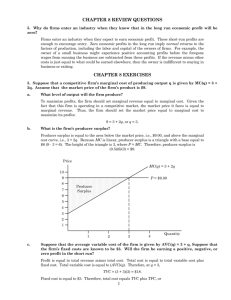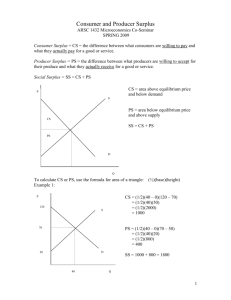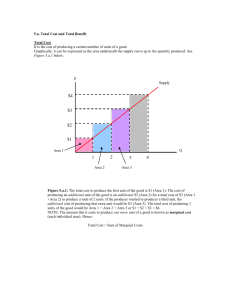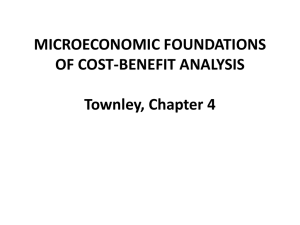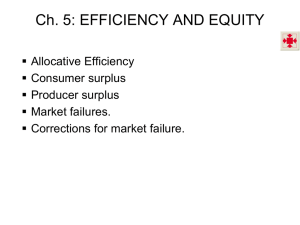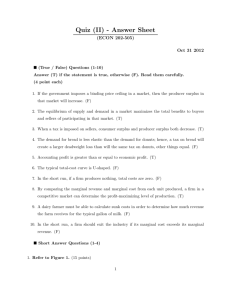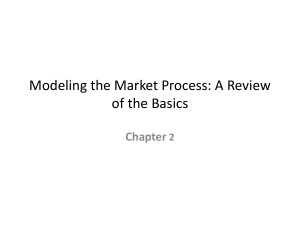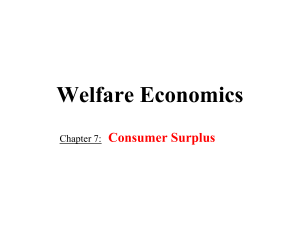R`(x)
advertisement
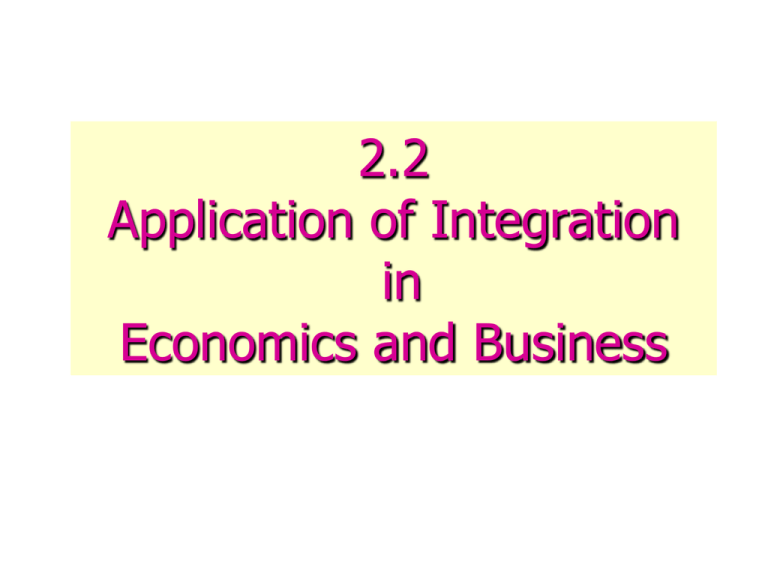
2.2 Application of Integration in Economics and Business OBJECTIVE : At the end of the lesson, students should be able to • find the revenue and cost functions from the marginal revenue and marginal cost functions • define consumer’s surplus and producer’s surplus regions • find the market equilibrium point REVENUE FUNCTION MARGINAL REVENUE R’(x) TOTAL REVENUE FUNCTION antiderivative R(x) For any demand function : y = f(x) y is the price per unit and x is the number of units (demand) TOTAL REVENUE, R(x) and MARGINAL REVENUE, R’(x) R is the product of x and y R(x) = xy = x.f(x) Marginal revenue with respect to demand is the derivative with respect to x of the total revenue dR R' ( x) dx Total revenue function is the integral with respect to x of the marginal revenue function: R ( x) R ' ( x)dx And, since R ' ( x ) dx R ( x ) k An initial condition must be specified to obtain a unique total revenue function. The initial condition : x = 0, R(x) = 0 Revenue is zero if demand is zero is frequently used to evaluate the constant of integration. R(0) 0 Example 1: If the marginal revenue function is R’(x) = 8 – 6x – 2x 2 determine the total revenue function. Example 2: The marginal revenue function for a company’s product is R’(x) = 50 000 – x, where x equals the number of units produced and sold. If total revenue equals 0 when no units is sold, determine the total revenue function for the product. COST FUNCTION If the total cost y of producing and marketing x units of a commodity is given by the function y = C(x) Then the marginal cost is C ’(x) dC = C’(x) dx MARGINAL COST Marginal cost is the derivative with respect to x, C’(x), of the total cost function y = C(x). Thus total cost is the integral with respect to x of the marginal cost function that is, y C ' ( x ) dx = C(x) + k an initial condition must be specified to obtain a unique total cost function Frequently this specification is in terms of a fixed cost or initial overhead that is, the cost when x = 0. x 0, C ( x) fixedcost Example 3: Marginal cost as a function of units produced is given by C’(x) = 1.064 – 0.005x, find the total cost function if fixed cost is 16.3. Example 4: The marginal cost of producing a product is C’(x) = x + 100 where x equals the number of units produced. It is also known that total cost equals RM40 000 when x = 100. Determine the total cost function. CONSUMER’S SURPLUS REGION Suppose that p is a price that consumer willing to pay for a quantity x of a particular goods. The demand curve can be written as follows: p = D(x) In general, the demand curve is a decreasing function. If the market price is yo and the corresponding market demand is xo, then the total savings to consumers who are willing to pay more than yo for the product and are still able to buy the product for y0 is represented by area below the demand curve and above the line y = yo and is known as consumer’s surplus (C.S) price yo C.S p = D(x) xo Figure 1 quantity price C.S yo p = D(x) xo quantity Figure 2 price C.S yo p = D(x) xo quantity Figure 3 Producer’s Surplus Region Suppose the price p that a producer is willing to charge for a quantity x of particular goods is governed by the supply curve. p = S(x) In general, the supply function S is an increasing function. If the market price is yo and the corresponding market supply is xo , the total gain to producers who are willing to supply units at a lower price than yo and are still able to supply units at yo is represented by the area above the supply curve and below the line y = yo and is known as producer’s surplus (P.S). price p = S(x) yo P.S xo Figure 5 quantity price p = S(x) yo P.S xo quantity Figure 6 price p = S(x) yo P.S xo Figure 7 quantity MARKET EQUILIBRIUM POINT The point of intersection of the demand curve and the supply curve is called the equilibrium point of a free market, which indicated by point E.P. The coordinate of E.P is (xo, yo), price p = S(x) C.S yo E.P(xo, yo) P.S p = D(x) xo Figure 9 quantity yo is the price at which producer is willing to supply and xo is the quantity of the goods purchased by the consumer and supplied by the producer. This equilibrium condition is expressed by the equation : D(x) = S(x) Formula to determine Consumers’ surplus xo C.S = D( x)dx x o yo 0 Formula to determine Producer’s Surplus xo P.S = x o y o S ( x)dx 0 Example 5: Determine the consumers’ surplus region at a price level of RM8 for the price-demand equation D(x) = 20 – 0.05x Example 6 Determine the producers’ surplus region at a price level of RM20 for the price-supply equation: S(x) = 2 + 0.0002x 2. Then find the producer’s surplus. Example 7 Find the equilibrium point, if D(x) = 20 – 0.05x and S(x) = 2 + 0.0002x 2. Example 8 Find the producers’ surplus at a price level of RM 7 for the price-supply equation, S(x) = 2x + 1 Example 9 Find the consumers’ surplus at a price level of RM8 for the price-demand equation, D(x) = 20 - 0.05x Example 10 Find the consumers’ surplus at a price level of RM4 for the price-demand equation, D(x) = 7 – x Example 11 If the demand function is y = 16 – x2 and the supply function is y = 2x + 1, find the equilibrium price and determine consumer’s surplus and producer’s surplus area under pure competition. Exercise Find the equilibrium price and then find the consumers surplus and producers surplus at the equilibrium price level if D(x) = 20 – 0.05x and S(x) = 2 + 0.0002x2

